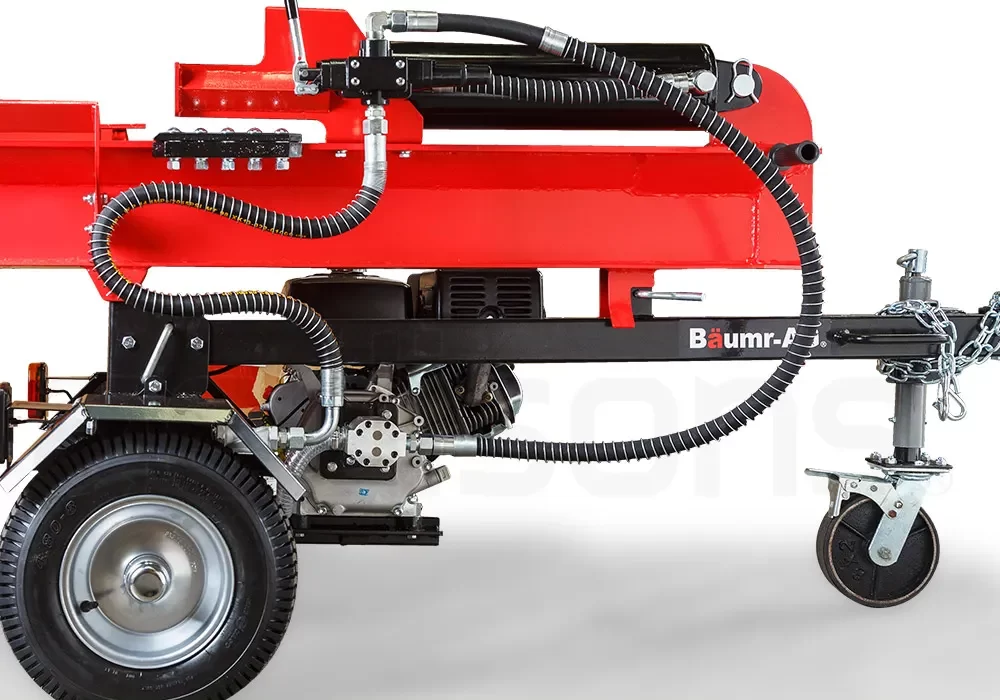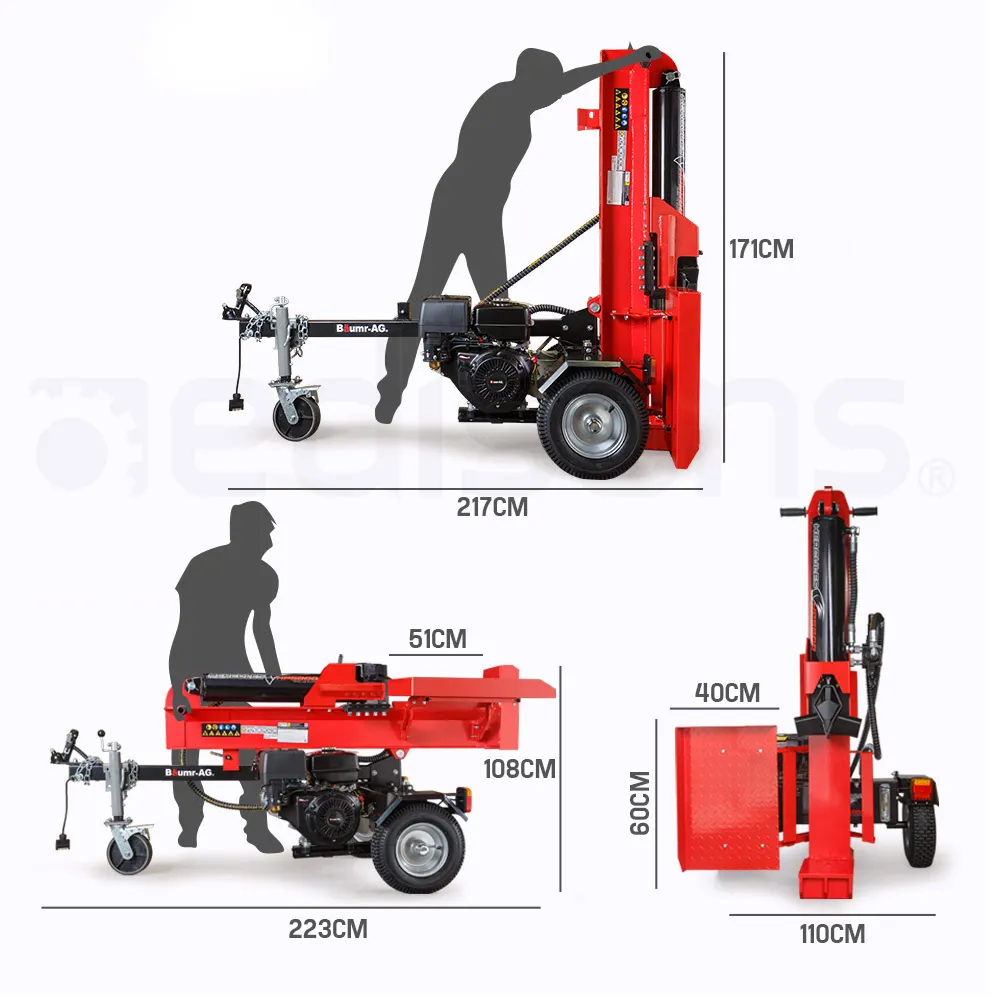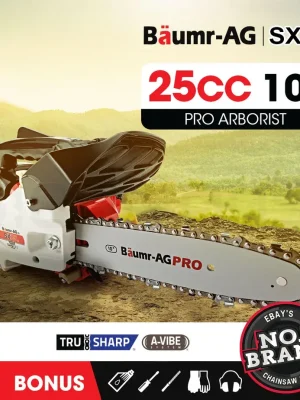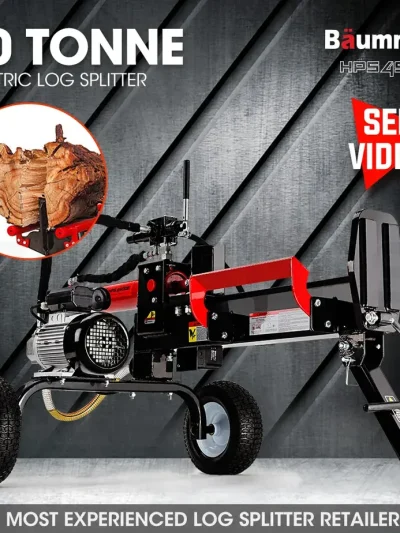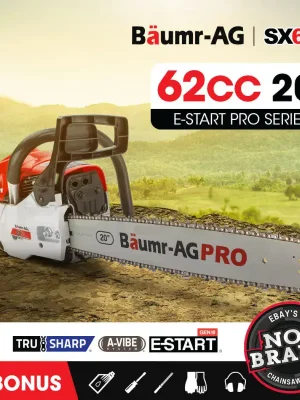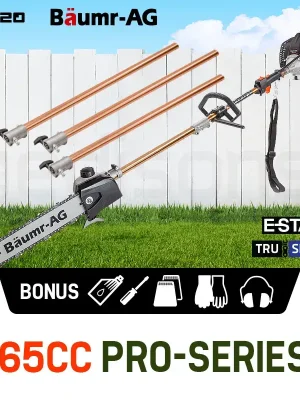Safety reminder: Always follow the manufacturer’s instructions, wear PPE (eye, ear, gloves, steel‑caps), and operate on level ground with a clear exclusion zone.
65 Tonne Petrol Hydraulic Log Splitter – Towable, Vertical | Horizontal (Full Review)
A heavy-duty, towable 65 Tonne Petrol Hydraulic Log Splitter built for big Australian hardwoods and seasonal wood prep. This guide explains how it works, who it suits, and how to use it safely.
Last updated: 15 August 2025 (AEST)
Overview: what this 65‑tonne splitter is and where it shines
The 65 Tonne Petrol Hydraulic Log Splitter is a towed, petrol‑driven machine built for large volumes of tough, seasoned or green hardwoods. It can be operated in both horizontal and vertical modes: horizontal for efficiency when handling manageable rounds, vertical for large diameter, heavy logs that are unsafe to lift.
It’s a strong fit for rural properties, CFA volunteers preparing firewood for stations or community programs, contractors clearing storm‑blown timber, and households who split hard timbers like ironbark, red gum, or spotted gum. Tow it around the block (within rating), wheel it into position, chock the tyres, and you’re ready to split.
The key difference at this size is cycle efficiency and the ability to maintain splitting force through tough grain, knots, and twisted fibres. A high‑tonnage ram with a well‑matched hydraulic pump, large oil capacity, and a sturdy beam keeps the wedge moving when lighter machines stall.
Key Features of the 65 Tonne Petrol Hydraulic Log Splitter
Massive splitting force
Up to 65 tonnes of rated force to crack dense Aussie hardwoods that bend lighter wedges.
Dual‑mode beam
Quickly switch between horizontal and vertical to suit log size and operator safety.
Towable chassis
Heavy‑duty drawbar, safety chains, LED lighting (where fitted) and fenders for site moves.
Robust hydraulics
High‑flow pump, quality hoses, generous reservoir and return filtration for cooler running.
Operator‑friendly deck
Wide log cradles, anti‑roll supports and an accessible control lever reduce fatigue.
Serviceable design
Greaseable pivots, replaceable wedge, easy access to filters, belts, and engine service points.
How it works: from petrol to hydraulic power
A petrol engine spins a hydraulic pump that pressurises oil. That oil drives a cylinder (ram) to push timber into a hardened steel wedge. The 65 Tonne Petrol Hydraulic Log Splitter keeps pressure on the grain until fibres give way. Auto‑return brings the ram back to start the next cycle.
Use horizontal mode for manageable logs and fast throughput. For very heavy rounds, tilt to vertical, roll the log into place, and split without straining your back. Maintain a tidy work area so offcuts fall clear of controls and wheels.
Benefits & advantages for Aussie users
- Less lifting, more splitting: vertical mode handles oversized rounds safely.
- Through tough grain: 65‑tonne force drives wedges through knots and twisted fibres.
- Lower downtime: robust hydraulics and filtration keep oil cool and clean.
- Made for distance: towable between paddocks or work sites (within rating and local regs).
- Team productivity: ideal for community wood‑banks and station wood days.
Limitations & safety considerations
- Size & weight: at this tonnage, the unit is heavy. Move slowly on slopes and avoid soft ground.
- Noise & fumes: petrol engines are loud—use hearing protection and operate outdoors, away from enclosed sheds.
- Hydraulic hazards: hot oil and high pressure. Never check leaks with hands; use cardboard and wear gloves.
- Pinch/crush risks: keep hands clear of the wedge and beam. Use tongs or a timber hook to position pieces.
- Towing rules: observe local regulations for lighting, safety chains and speed. This is a work‑site mover, not a highway tourer unless rated and registered accordingly.
Store with the engine off, fuel tap closed, and the ram fully retracted. Lock out the control lever when not in use and park under cover to protect hoses and seals from UV.
User scenarios: real‑world examples
Fire service wood drive
A CFA brigade runs a weekend wood split to help locals prepare for winter. Vertical mode handles the big gum rounds. Wide cradles keep pieces stable, and a spotter manages the exclusion zone.
Storm clean‑up contractor
After a wind event, the splitter processes mixed hardwood heaps on rural blocks. Towing between sites saves time; the high‑flow pump powers through twisted fibres without constant stalls.
Homestead firewood program
A property owner preps a season’s worth of firewood in autumn. Horizontal workbench mode speeds small rounds, while vertical mode splits stumps too heavy to lift.
Maintenance & care guide
- Oil & filter: change hydraulic oil and return filter per schedule; check for milkiness (water ingress) and burnt odour (overheating).
- Hoses: inspect for abrasions, bulges and leaks; replace at the first sign of damage.
- Wedge & beam: keep edges clean; a light film of oil prevents rust. Replace or sharpen the wedge if it mushrooms or chips.
- Engine service: fresh fuel, clean air filter, correct spark plug gap, and scheduled oil changes keep starts reliable.
- Fasteners & pivots: torque check the beam pivot and tow hardware; grease all nipples as per the manual.
- Storage: park undercover, cover the cylinder rod, and chock wheels to prevent creep.
Before each session, complete a quick check: tyre pressure, chains connected, chocks available, PPE on, controls functioning, and a tidy work area with good footing.
Comparison table: is 65‑tonne overkill for you?
| Model | Best for | Force | Cycle feel | Pros | Cons |
|---|---|---|---|---|---|
| 65‑tonne petrol (towable) | Dense hardwood, big knots, community days | Very high | Confident through gnarly grain | Vertical + horizontal, serious power, less stalling | Heavier, louder, higher upfront cost |
| 40‑tonne petrol | Mixed hard/softwood, households | High | Good pace on most rounds | Lower cost, easier to tow and store | May hesitate on big knots; more resplitting |
| Electric horizontal (10–15‑tonne) | Courtyards, light duty, softwoods | Low–medium | Quieter, but slow on hardwood | Low noise, indoor (well‑ventilated) use, compact | Not suited to Aussie hardwood or oversize rounds |
Need serious splitting power?
Check current price and delivery options for a 65‑tonne towable splitter in Australia.
FAQs
What fuel does it use?
Unleaded petrol for the engine; hydraulic oil for the ram circuit. Follow the manual’s grade and capacities.
Can it split stringy or knotted gum?
Yes—65‑tonne force with a sharp wedge keeps moving through tough, interlocked grain where small units stall.
Horizontal vs vertical—when to use which?
Horizontal for speed with manageable rounds; vertical when logs are too heavy to lift safely.
What PPE is essential?
Safety glasses, hearing protection, gloves, long pants, and steel‑capped boots. Tie back hair and remove jewellery.
How big can the logs be?
Depends on the workbench and wedge height, but vertical mode handles larger diameters because you can roll rounds in.
Is it road‑legal to tow?
Many are designed for work‑site speeds. For public roads, comply with local towing regs, lights, and registration if required.
How noisy is it?
Comparable to a small petrol generator. Use hearing protection and brief your neighbours if operating for long sessions.
How do I avoid jam‑ups?
Keep the wedge sharp, split with the grain, and re‑orient stringy pieces. Use the log cradles so offcuts don’t bind on the beam.
Ready to upgrade your firewood setup?
Grab a high‑capacity, towable 65‑tonner for tough hardwoods and save your back.
Where to buy in Australia
- Edisons – national delivery and spare parts support.
Links & manuals
- Manufacturer page: Edisons (AU)
- Work health & safety guidance: Safe Work Australia
- Victorian regulator: WorkSafe Victoria
- Machinery standards overview: Standards Australia (AS 4024 series)
Always use the exact manual for your model; specifications, capacities, and towing limits vary.
Credits & review notes
This review is written for Australian conditions with a focus on safety, practicality, and year‑round use. Testing notes reflect mixed hardwoods, varied moisture content, and typical rural work sites. If you split daily for commercial supply, consider spare hoses, filters, and a preventive‑maintenance calendar.
Disclosure: outbound retailer links may be affiliate links that help support our work at no extra cost to you.
Emergency contacts – Australia
- Triple Zero (000): Fire, Police, Ambulance
- SES (flood/storm): 132 500
- VicEmergency Hotline: 1800 226 226
- Poisons Information: 13 11 26
- WorkSafe Victoria: 1800 136 089
Quick maintenance tips
- Check hydraulic oil level and colour before each use.
- Torque‑check tow coupling, wheel nuts, and beam pivot monthly.
- Grease sliding faces lightly; keep wedge clean and sharp.
- Inspect hoses quarterly; replace on age or damage—don’t wait for leaks.
For professionals
Adopt a two‑person workflow: an operator and a spotter/log‑feeder. Use radio or hand signals, enforce a 3‑metre exclusion zone, and rotate tasks every 30–45 minutes to manage fatigue. Record hours against a maintenance schedule and heat‑cycle the hydraulics before heavy runs.
Disclaimer: Always follow safety protocols, local regulations, and formal training when using powered equipment.




